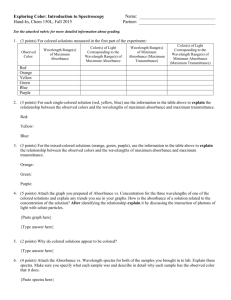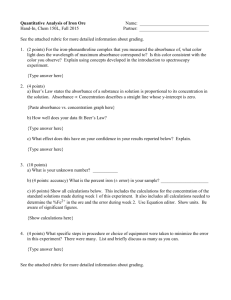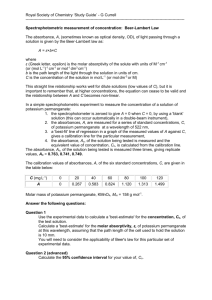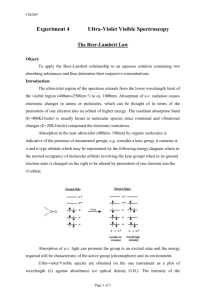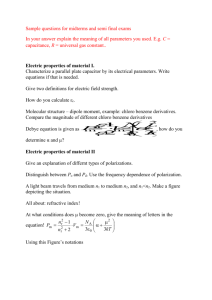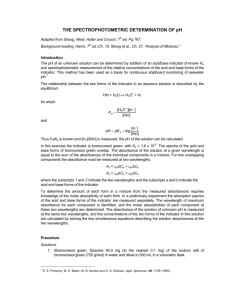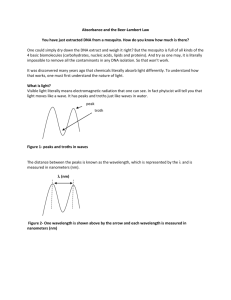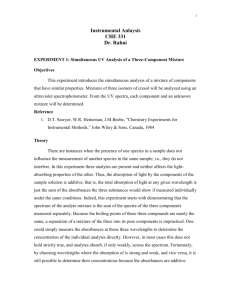Simultaneous determination of two dyes in solution
advertisement
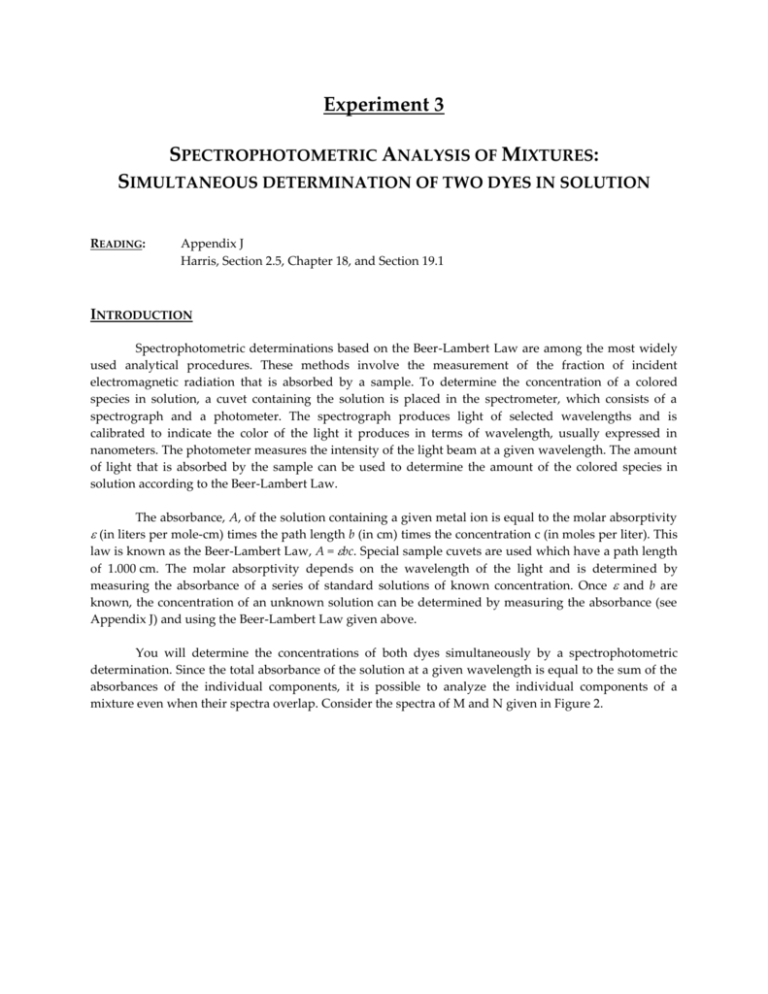
Experiment 3 SPECTROPHOTOMETRIC ANALYSIS OF MIXTURES: SIMULTANEOUS DETERMINATION OF TWO DYES IN SOLUTION READING: Appendix J Harris, Section 2.5, Chapter 18, and Section 19.1 INTRODUCTION Spectrophotometric determinations based on the Beer-Lambert Law are among the most widely used analytical procedures. These methods involve the measurement of the fraction of incident electromagnetic radiation that is absorbed by a sample. To determine the concentration of a colored species in solution, a cuvet containing the solution is placed in the spectrometer, which consists of a spectrograph and a photometer. The spectrograph produces light of selected wavelengths and is calibrated to indicate the color of the light it produces in terms of wavelength, usually expressed in nanometers. The photometer measures the intensity of the light beam at a given wavelength. The amount of light that is absorbed by the sample can be used to determine the amount of the colored species in solution according to the Beer-Lambert Law. The absorbance, A, of the solution containing a given metal ion is equal to the molar absorptivity (in liters per mole-cm) times the path length b (in cm) times the concentration c (in moles per liter). This law is known as the Beer-Lambert Law, A = bc. Special sample cuvets are used which have a path length of 1.000 cm. The molar absorptivity depends on the wavelength of the light and is determined by measuring the absorbance of a series of standard solutions of known concentration. Once and b are known, the concentration of an unknown solution can be determined by measuring the absorbance (see Appendix J) and using the Beer-Lambert Law given above. You will determine the concentrations of both dyes simultaneously by a spectrophotometric determination. Since the total absorbance of the solution at a given wavelength is equal to the sum of the absorbances of the individual components, it is possible to analyze the individual components of a mixture even when their spectra overlap. Consider the spectra of M and N given in Figure 2. There is obviously no wavelength at which the absorbance of this mixture is due simply to one of the components; thus an analysis for either M or N by a single measurement is not possible. However, the absorbances of the mixture at the wavelengths 1 and 2 may be expressed as follows: At 1 : A1 1M bcM 1N bcN At 2 : 2 A2 M bcM N2 bcN 2 The four molar absorptivities 1M , M , 1N , and N2 can be evaluated from standard solutions containing only M or N. Then, if the absorbances of the mixture are measured at 1 and 2, the concentration of the individual components can be calculated by solving the two equations given above simultaneously. The best accuracy in an analysis of this sort is obtained by choosing wavelengths at which the differences in molar absorptivities between the two ions is large. For your unknown, you will use the absorption spectra of yellow and red dyes to choose two wavelengths. In this lab you will also gain experience in writing a formal laboratory report. EXPERIMENTAL 1. Obtain solutions of Yellow 5 (50 mg/L) and Red 40 (50 mg/L). You will need to create dilutions in order to measure the extinction coefficient 2. Obtain the unknown orange solution in the requested glassware. It should be clean, dry, and labeled with your name and locker number. 3. Measure the absorbance vs. wavelength for the yellow dye and red dye solutions using the diode array spectrophotometer in Spectrum/Peaks mode. From these data, select the two wavelengths that will produce the greatest accuracy in this determination. Consider the influence of concentration. Check these values with your TA before you proceed. 4. Measure the absorbance spectra of each known solution and your unknown mixtures in Fixed Wavelengths mode at both wavelengths chosen. An accurate absorbance measurement is best made when the A is between 0.1 and 1.0. If your unknown has an A above 1 you should quantitatively dilute. If your A is below 0.1 you have diluted too much. ANALYSIS From the absorbance data on the known solutions prepare four standard curves, one for each ion at each of your chosen wavelengths. Using the techniques of linear regression described in Harris, determine the slopes (b) of these curves and their 95 % confidence limits. Using these slopes and the absorbance measurements made at the two wavelengths, determine the concentrations of both dyes in your unknown. Determine the 95 % confidence limits, assuming that all of the uncertainty comes from the slope measurements. If time permits you can also use the known spectra over the entire wavelength span to perform a component decomposition of your unknown data. This is done by importing your full standard and unknown spectra into an Excel spreadsheet for analysis. Give it a try. FORMAL LAB REPORT POINT BREAKDOWN Abstract (4 pts): A concise description of what was determined in the lab Experimental goals/motivation Experimental methods used to obtain results Final results Introduction (6 pts) Background info on the experiment/why is this technique useful Conceptual description of the experimental techniques and analysis methods Statement of what was achieved o End goal o Milestones on the way to the goal, if any Experimental methods (3 pts): This is where the details of the experiment are discussed. Focus on descriptions of the aspects of the procedure that were critical to the experimental outcome and details that would be necessary for someone to repeat the experiment (e.g. in the spectrophotometric analysis lab the spectrophotometer used, wavelengths used, etc.). Do not just repeat the steps as outlined in the manual. Results (11 pts): Data plots (including titles, captions, and labeled axes) Data tables (be sure they are clearly formatted/east to read and include a caption) Calculations with units (in some cases a representative calculation is fine) Calculated error (if applicable) Discussion (10 pts): This section is a summary of what was learned in the experiment, including explanations of the final results, observations, data, sources of error, and how the error affected the data. Are there aspects of the experiment that could be improved; are there remaining questions that could be addressed in future experiments? References (1 pt): ACS style guidelines (http://library.williams.edu/citing/styles/acs.php) General quality (3 pts): Grammar, formatting, quality of writing, etc. Lab practice (2 pts)
